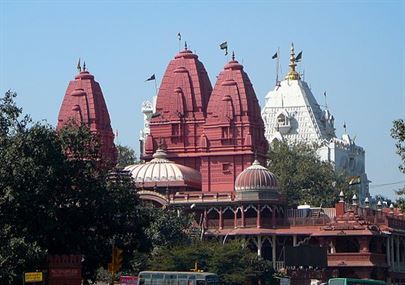Shri Digamber Jain Lal Mandir (Hindi: श्री दिगंबर जैन लाल मंदिर Śrī Digambar Jain Lāl Mandir) is the oldest and best-known Jain temple in Delhi, India. It is directly across from the Red Fort in the historical Chandni Chowk area..
When Shah Jahan built the Qila e Mubarak now known as Red Fort or Lal Qila he also invited several Agrawal Jain merchants to come and settle in the city and granted them some land south of the Chandni Chowk around Dariba Gali.
He had many Jain soldiers in his army too.
One of the Jain soldiers kept 3 idols opposite the Fort ‘ s Lahori Gate. These idols were from 1493 AD and all the Jain soldiers worshipped them. The idols were kept in a small tent and because it was a temple belonging to the army camp – Urdu means camp – it was called Urdu Mandir.
( the word Urdu used for a language was only a development post 1857 when the British tried to divide on linguistic lines by using Persian script and Persian used words for Muslims and Sanskritised Hindi and Devnagri script for Hindus. Till then it was Hindavi/ Rekhta/ Hindustani that was the common language for common people. )
Later the Agrawal Jain community acquired the three marble idols and built a temple over it on the same spot as the tent in approximately 1656 AD.
In 1800-1807, Raja Harsukh Rai, the imperial treasurer obtained imperial permission to build a temple with a sikhara in the Agrawal Jain neighborhood of Dharamapura, just south of Chandani Chauk. Thus temple, known for fine carvings, is now known as the Naya Mandir “New Temple”
It’s red walls also gave it the name Lal Mandir.
According to legend Aurangzeb once gave orders that no drums should be beaten here but the sound of drumming continued. Nobody could be seen beating them. The Emperor went himself to satisfy himself that no one was beating them and found it to be true. He immediately gave orders that the temple drums were to be beaten at all times without any restrictions on them.
A new marble shikhar has been built but the three idols are kept in the sanctum sanctum of the old temple.
It’s a highly venerated temple. The main icon is that of Tirthankara Parshva.
Source Maulvi Zafar Hasan and wikipedia )


